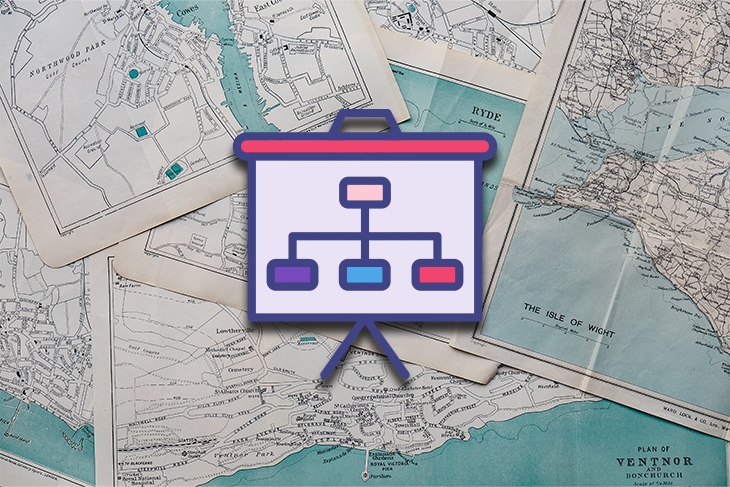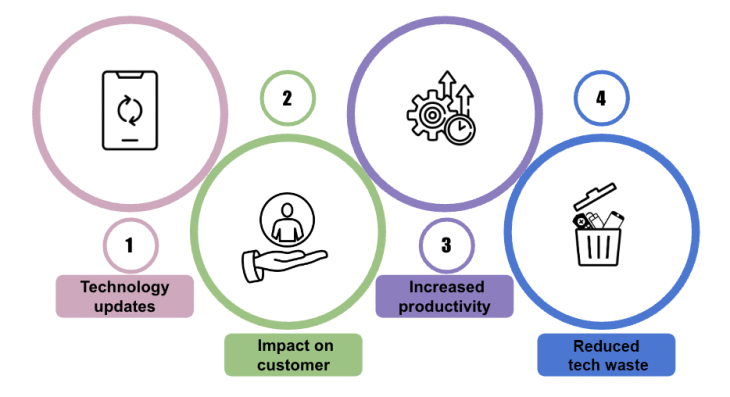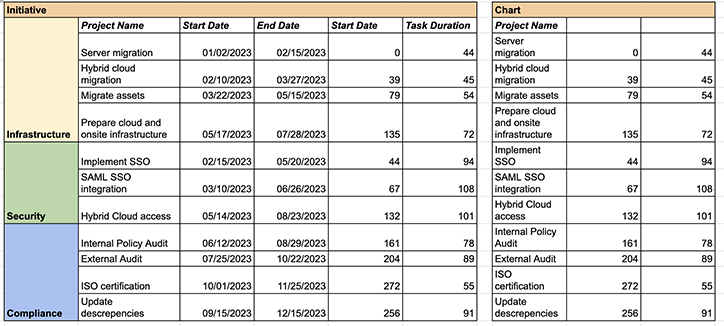Organizations need to update the technologies for their products to reduce costs, increase efficient operations, increase productivity, and create a better user experience.

IT teams have the responsibility of ensuring the quality of not only the digital products offered to customers, but also that tools used by internal teams are regularly upgraded. IT teams have to ensure the applications, architecture, and technology for both internal and external products are working optimally to help achieve the goals of the organization.
Roadmaps are often associated with the product roadmaps created by product managers. Other teams can benefit from creating roadmaps, however, to communicate strategy, areas of focus, and timelines for implementing their projects.
In this article, we’ll talk about technology roadmaps. We’ll cover what they are, why they exist, and different types of technology roadmaps. We’ll also talk about how to create, communicate, and share technology maps, and provide examples and templates.
IT teams are now adopting the creation of roadmaps. They help communicate the strategy for the organization, specifically regarding how technology will evolve in a certain timeframe.
Technology roadmaps, AKA IT roadmaps, are high-level plans that communicate the technology strategy of the organization. They help everyone in the organization understand the what, why, and when of all the IT initiatives planned.
Technology roadmaps also indicate crucial dates on the map for any start-of-life or end-of-life software for both external and internal users of the organization.
For example, an ERP system currently being used by company employees is being replaced by a new ERP product. The technology roadmap indicates the crucial dates for ending the support for the current ERP and the start of the new ERP system.
Technology roadmaps can serve many purposes when created and communicated at the right time. An organization can have different teams working on various business lines, like product, customer success, marketing, and human resources, for example.
Each of these divisions uses a different set of tools to accomplish its goals, and the IT team is responsible for providing infrastructure and technology for all of them. There are many purposes of a technology roadmap, and we’ll go over some below.
A technology roadmap, when shared by the IT team, helps the different teams align with the upcoming software changes. They’ll be aware of when a current software will have an upgrade available or if it’s being deprecated.
For the current products owned by an organization, there could be a planned infrastructure change that can increase the performance of the product. This can lead to an increase in customer satisfaction and adoption.
Upcoming technology changes noted by the technology roadmap can help the other teams plan their activities accordingly. This leads to increased productivity, as their activities and tasks are better aligned with the upcoming changes.
Formulating a technology roadmap can help the IT team decide the number of SaaS subscriptions needed. Prior collaboration with other teams to estimate the number of subscriptions and corresponding costs can help cut out unnecessary or unused subscriptions.

Different types of roadmaps can be created to communicate current capabilities, upcoming changes, and goals within timelines. All of these roadmaps can be subsets of a bigger roadmap as they are related to the current tools/software. For instance, there can be separate roadmaps for communicating the evolving architecture of products, infrastructure, and/or security.
Let’s take a look at different types of technology roadmaps:
An IT systems roadmap conveys the software and infrastructure used by internal teams. The roadmap indicates the technology needed to run the day-to-day operations of an organization. It outlines improvements and future IT needs along with current capabilities.
Software used by internal teams, such as CRM, ERP, data analytics, and knowledge management, is indicated on the roadmap along with upcoming upgraded versions and their start dates. Technology roadmaps may also be shared with vendors or partners depending on the type of engagement.
Every team can develop its roadmap to accomplish its goals as they align with the business goals.
Development teams working towards developing a product for a company also need a roadmap where they can outline a plan for releasing a product into the market. This might involve chalking out sprints and designating certain amounts of work due by a specific date.
IT teams, like the security team, can create their roadmap to outline the current capabilities and upcoming improvements of the security system. Similarly, there can be another roadmap to convey infrastructure improvements outlined within a specific timeframe.
Some software organizations find it necessary to lay out the plan for their products’ changing architecture. This enables all the architecture changes to stay maintained in one document. It outlines current third-party integrations, APIs, storage, and more for the product, and also upcoming changes or upgrades within the next few quarters.
The Open Group Architecture Framework (TOGAF) is a standard often used to create architecture roadmaps. This roadmap gives a high-level view of evolving architecture backing the product(s) to the chief executives of the organization.
While building a technology roadmap, it’s important to include the most crucial components. To build a quality roadmap, follow these five steps:

What can we gain from the technology roadmap? What is the reason behind it? These are crucial points to be convey in the roadmap. It’s important to keep this in mind and showcase how the roadmap can help achieve company goals.
Once you’ve determined the goal, the next step is to figure out who you’re presenting it to. Depending on the type of audience, you can either keep or remove certain details included in the roadmap.
For example, if the roadmap is going to be presented to C-suite executives, it should have high-level details highlighting the benefits the team and company want to achieve. If the roadmap is going to be shared with different target audiences, it can be tweaked to the needs of each audience before sharing.
Since you’ve already outlined the goals, it’s time to turn those goals into high-level initiatives and decide the timeline. These high-level initiatives can be further drilled into epics.
Laying out the plan helps in understanding how and when to execute the goals.
Once the roadmap has all these details figured out, prepare a presentation with a compelling message to indicate the benefits the roadmap will achieve. You must be ready to answer any questions that relevant stakeholders might have.
After addressing stakeholder feedback and the refining the roadmap further, it’s time to meet with the different teams who will be executing it. Ensure that everyone understands the objectives, how to execute them and in what order, and the time needed for each project.
Your responsibility does not stop at creating the roadmap. Instead, you’ll have to update document from time to time based on changing business needs. There could be a preplanned initiative that now doesn’t make sense because of the change in company goals, market, or user needs. Hence, it is fundamental to revise the roadmap every few months to accommodate unplanned changes.
To achieve an effective roadmap that can leave an impact on key stakeholders, you must spend time polishing your key message, explaining the reason behind the roadmap.
This must align with the business goals of the company and clearly indicate how it aligns. Now, let’s take a look at the various steps for communicating and sharing the technology roadmap.
Create a presentation indicating the reasoning behind the roadmap, the major initiatives it entails, and how the benefits help in achieving the company’s objectives. Your roadmap should be visually compelling.
In the presentation, focus on the why and how the roadmap addresses the needs of the target audience.
Understand the audience you will be presenting the roadmap to. Chalk out their interests and influence by creating a matrix. This will be helpful to understand how crucial each stakeholder is and how to communicate with each one of them.
Before the presentation, think about each stakeholder attending the presentation and what their feedback or questions may be. Prepare your answers and analyze if the roadmap initiatives are aligning with the interests of these stakeholders.
If you don’t know them well before creating the presentation, it’s time to approach each one and figure out their interests, goals, and challenges. Meeting them beforehand will help to understand their interests, challenges, and goals.
Review initiatives outlined in the roadmap and analyze if they match the expectations of the stakeholders.
Share the roadmap with relevant stakeholders and an accessible place. You’ll want them to be able to visit at any time to take a look at it. Any changes to the roadmap must be reflected in real-time to avoid any communication gaps.
Don’t forget to follow up with stakeholders on any feedback they might have to share. Make sure they can provide the feedback at a designated place and at any time post-presentation.
This feedback must be reviewed and discussed with stakeholders. If all stakeholders agree with the change, the roadmap must be updated.
Based on changing conditions of the market, customer, and business needs, frequently review and update the roadmap on a timely basis. The stakeholders need to be notified of the new change to the technology roadmap.
Here is a Google Sheet template that you can use to create a technology roadmap. Feel free to make a copy and modify it as needed:

Thanks for taking the time to read this article! I hope that this was insightful and gave you valuable information about technology roadmaps. They are a great tool that can increase transparency throughout an organization and save lots of time and resources!
Featured image source: IconScout
LogRocket identifies friction points in the user experience so you can make informed decisions about product and design changes that must happen to hit your goals.
With LogRocket, you can understand the scope of the issues affecting your product and prioritize the changes that need to be made. LogRocket simplifies workflows by allowing Engineering, Product, UX, and Design teams to work from the same data as you, eliminating any confusion about what needs to be done.
Get your teams on the same page — try LogRocket today.

Great product managers spot change early. Discover how to pivot your product strategy before it’s too late.

Thach Nguyen, Senior Director of Product Management — STEPS at Stewart Title, emphasizes candid moments and human error in the age of AI.

Guard your focus, not just your time. Learn tactics to protect attention, cut noise, and do deep work that actually moves the roadmap.

Rumana Hafesjee talks about the evolving role of the product executive in today’s “great hesitation,” explores reinventing yourself as a leader, the benefits of fractional leadership, and more.